 |
Flying High With Electric Power!
The Ampeer ON-LINE!
Fly the Future - Fly Electric! |
Site Table of Contents
| President: | Vice-President: | Secretary/Treasurer: |
| Ken Myers | Richard Utkan | Rick Sawicki |
| 1911 Bradshaw Ct. | 240 Cabinet | 5089 Ledgewood Ct. W. |
| Commerce Twp., MI 48390 | Milford, MI 48381 | Commerce Twp., MI 48382 |
| (248) 669-8124 | (248) 685-1705 | 248.685.7056 |
 | ||
| Board of Directors: | Board of Directors: | Ampeer Editor |
| David Stacer | Arthur Deane | Ken Myers |
| 16575 Brookland Blvd. | 21690 Bedford Dr. | 1911 Bradshaw Ct. |
| Northville, MI 48167 | Northville, MI 48167 | Commerce Twp., MI 48390 |
| 248.924.2324 | 248.348.2058 | 248.669.8124 |
| Mailed Ampeer printed subscriptions are no longer available.
The Ampeer is FREE on-line in Acrobat .pdf format and HTML with active links! | ||
| The Next Meeting:
Date: Thursday, March 14 Time: 7:30 p.m. Place: Ken Myers' house, Commerce Twp., MI | ||
| What's In This Issue? | ||||
| Another TigerKitten, Ron Fikes shares photos and information on his recently acquired Bob Benjamin TigerKitten. | Invasion Stripe Rant Comment - Dave Segal comments on John Bell's comment about Invasion Stripes. | |||
| January 2013 EFO Meeting, Richard Utkan shares his Tom Hunt EDF, Charlie Dochenetz shares his under construction Sig LT-25, Jim Young shares progress on his HABU 32, and Ken Myers shares progress on his Bob Benjamin TigerKitten. | O.S. Engine/O.S. Motor OMA-5010-810 Review, Ken Myers tests this motor with specifications given and prop recommendations. | |||
| Regarding Replacements for AF 15G Motors in a Bell YFM-1A in the January 2013 Ampeer, Robert Comerford recommends a brushless replacement for this brushed motor. | Feather Merchant, Art Lane describes his electric conversion w/photo. | |||
| China Clipper Q500 and an Extra 300XS, Willie McMath shares info and photos of his electrified versions. | Looking for RC Micro World?, Ken Myers gives the current Web address for this publication. | |||
| One Cure for Motor "Rumbling", Greg Gimlick discusses how the PWM setting in an ESC should be set. | Power Meters and a Bristol M1C, Art Lane discusses power meters and his new Bristol M1C. | |||
|
From Ron Fikes via email A photo of Ken Myers is shown with his ACE TigerKitten under construction in the January EFO Meeting article in this issue. Ron asked a question about the CG and then came back with a couple of photos of his TigerKitten. KM 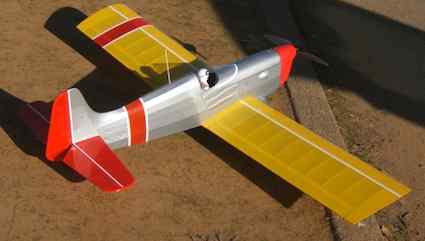 Ken, Many thanks for the balance info for my Kitten, that you gave me on RC groups. Mine has been flown four times. It is a good flyer but when it gets into ground effect, it does not want to come down! I am using a Hacker with an Astro Flight gearbox, APC 11 x 8, and 3S 2100 mAh LiPo. It only draws 18 amps. I may go to an outrunner next. I hate the old fashioned gearbox noise, but that is what was in the plane when I got it. Ron Fikes
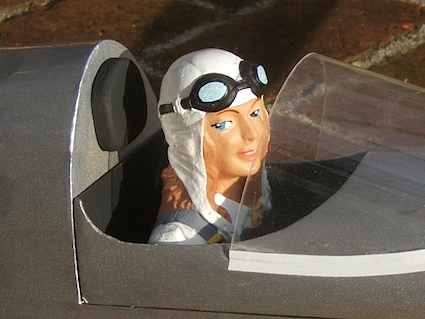 From Dave Segal Keystone RC Clubvia email John Bell's "Rant" surprised me because I did not think that anyone else felt the way I do. Younger modelers must think that invasion stripes were worn by every US combat aircraft for the entire war.vI have regarded this overuse of the stripes by kit manufacturers as a worn-out cliche. Now for my modest rant, why don't we see more of the P-51B versions of the Mustang which are really more sleek looking than the bubble canopy versions? I'll throw in one of my requests while on the P-51 topic; how about some North American A-36 Apaches? KM January 2012 EFO Meeting The meeting was held on the evening of January 10 at Ken's house.
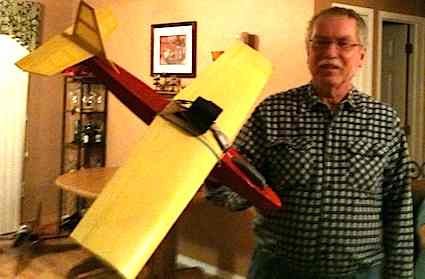 Richard Utkan, EFO VP, had a neat, little ducted fan model that he's been flying. It was made using some Tom Hunt plans that Richard had on hand. He substituted a foam wing from a chuck glider instead of the built up wing. A spar was added to the foam wing. It uses a Wattage ducted fan unit and brushless motor. The new power system has about three times the power output of the original brushed system. He has flown it quite a bit and says it is a lot of fun to fly. 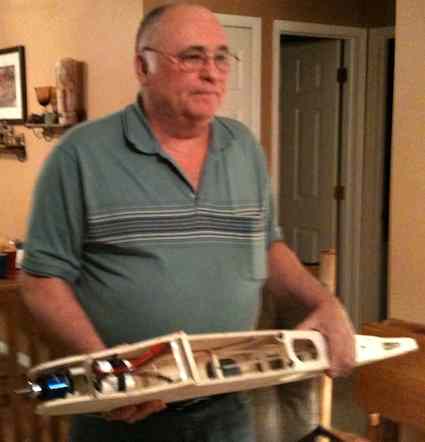 Charlie Dochenetz brought his Sig LT-25. He is making good progress on it. It uses the "X" cross type covering hinges for the movable surfaces. He's designed a very nice hatch/windscreen cover for it that allows easy access to the front end of the plane. It will use an O.S. Motor OMA-3825-750 brushless outrunner, Castle Creations' 50-amp Ice ESC and a 4S "A123" 2300mAh pack for the power system. 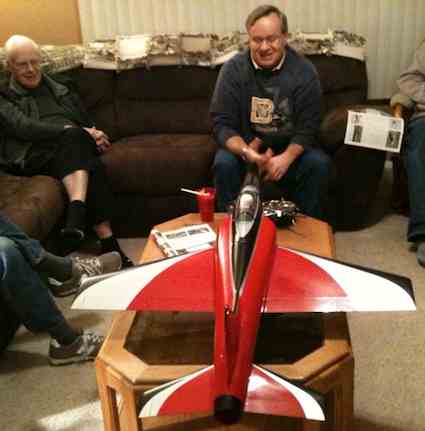 Jim Young shared his new Habu 32. He was pleased with the way it was going together and rated the overall quality good. He is using the recommended power system and retracts. 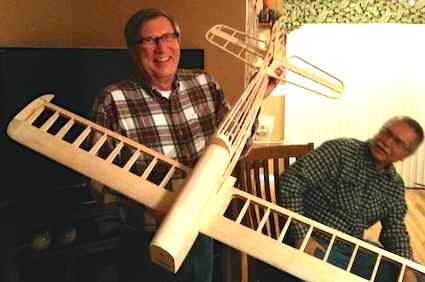 Ken Myers shared his Bob Benjamin TigerKitten. He's building it using many of the parts from a 1996 ACE kit that he had on the shelf. The front end has been modified to fit the larger than necessary O.S. Motor OMA-5010-810 brushless outrunner, Castle Creations' 50-amp Ice ESC and 4S &qwuot;A123" 2300mAh pack turning an APC 13x8E prop. After the show and tell, Ken did a presentation on Tips and Tricks for using Drive Calculator. Refreshments were served and the gather broke up about 10 p.m. It was another good EFO meeting! O.S. Engine/O.S. Motor OMA-5010-810 Review
The O.S. Motor OMA-5010-810 was ordered from Tower Hobbies on November 30 and arrived on December 3. Forward I purchased the O.S. Motor OMA-5010-810 brushless outrunner motor for use in a 1996 Bob Benjamin TigerKitten kit that I had on the shelf. I found the fit and finish of the outrunner motor to be very nice. I do not take my motors apart when testing them, so I have no comments about the actual internal construction. The TigerKitten has about 450 sq.in. wing area and is expected to weigh 3.44 lb./55 oz. and will use a 4S1P &^quot;A123" 2300mAh pack. I have a lot of experience with 4S "A123" 2300mAh power systems. I use a Scorpion SII-3026-710 (Scorpion 3852-815, 205g) with a 4S "A123" 2300mAh in the Super Stearman. The Super Stearman uses an APC 13x8E prop and initially draws about 35 amps at 11.43 volts for about 400 watts in. I also use a 4S "A123" pack in the "club trainer", a Thunder Tiger Lazy Tiger Cub. It is powered by an O.S. Motor OMA 3825-750 (O.S. Motor 3848-805, 193g). The OMA 3825-750 performed well through the remainder of the 2011 flying season and all of the 2012 flying season using an APC 12x8E prop. When the OMA 3825-750 power system combination was tested, it showed that approximately 5 seconds into the run of a fully charged 4S "A123" 2300mAh pack the numbers were; 11.77 volts, 33.8 amps, 397.8 watts in and 7920 RPM. Weights and Measures: All weights and measures matched O.S. MotorŐs data except for the motor weight being an insignificant 2.5g heavier. The 27mm prop washer cannot be used with an APC 12x10E. It does not 'clear' the blades near the hub. A Hyperion 8mm prop washer was substituted for testing. |
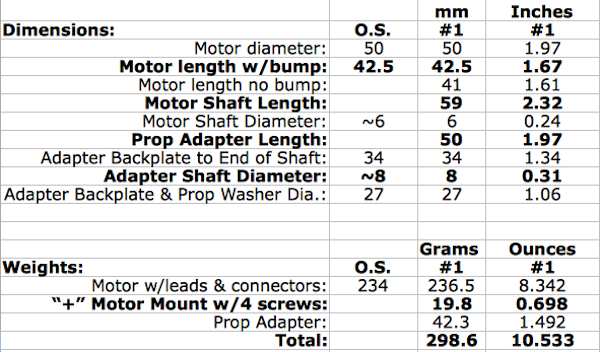
The OMA-5010-810, whose generic name (can diameter mm, can length mm dash Kv, wt. in grams) is an O.S. Motor 5043-810, 234g, according to the manufacturer's specifications, looked like a good choice for the TigerKitten. The information provided by O.S. Motor, and therefore Tower Hobbies, proved to be inaccurate. (See the article in the February 2013 Ampeer.) When I took the price and service into consideration, the O.S. Motor brand seemed to be a decent value. It listed for $104.98 but with the Super Saver discount it was $89.98 including the free shipping. To gather data for entry into Drive Calculator, a newly assembled 4S "A123" 2300 pack and brand-new Castle Creations Ice 50 were used. The Ice 50 was set to Low/0-deg timing, with all the remaining settings left at the default settings. was concerned that the Kv would not be what O.S. motor stated. I have three other O.S. Motor brushless outrunner motors, and the Kv was incorrect on all three examples. O.S. OMA-3820-1200 Review (two motors tested)
O.S. OMA-3825-750 Review
OMA-5010-810Kv
Therefore I give it the generic of: O.S. Motor 5043-790, 236g A Kv of 790 is within the measuring and manufacturing tolerances. It is only about 2.5% different. An Emeter II was used to gather all the data, NOT the onboard data from the Castle Creations Phoenix Ice 50 amp ESC. Two no load runs were logged and averaged for the no load inputs into Drive Calculator. Four props were logged, in this order, on the same battery charge, APC 12x8E, APC 12x10E, APC 13x8E and APC 13x10E. They were then averaged and used as the prop load inputs for Drive Calculator. The testing was done in the basement in Walled Lake, MI, USA.
After all of the data was input into Drive Calculator, a test using an APC 13x8E thin electric prop was completed at what I call 'take off' power. Approximately 3 seconds into the run of a fully charged 4S "A123" 2300mAh pack the numbers were; 10.82 volts, 37.7amps, 410 watts in and 7,000 RPM. With the 13x8 APC E V4 prop in Drive Calculator and the voltage set to a Constant voltage of 10.82 the Drive Calculator estimate is 37.9 amps, 410 watts in and 6,975 RPM. The elevation was set to 287m and temperature to 15-deg. C. Note that Drive Calculator notes the ns as 784 rpm/V. |
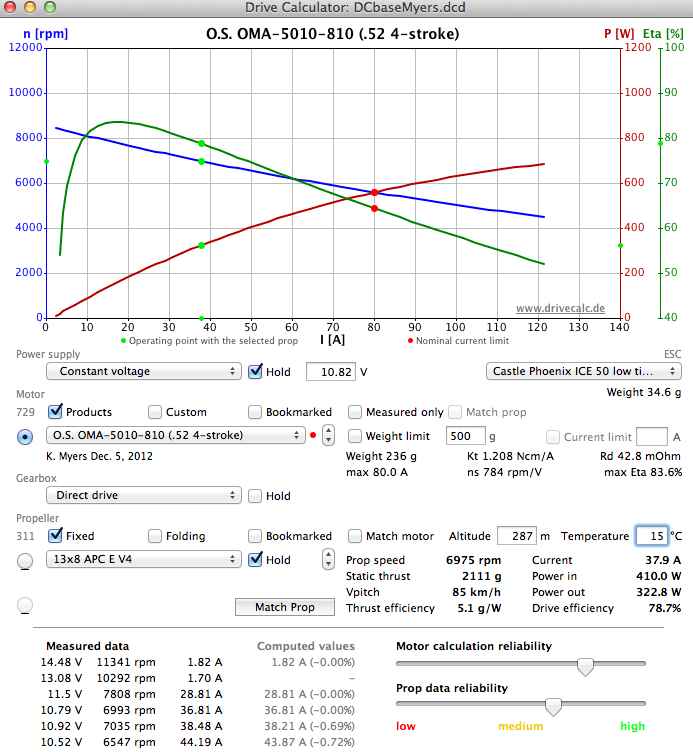
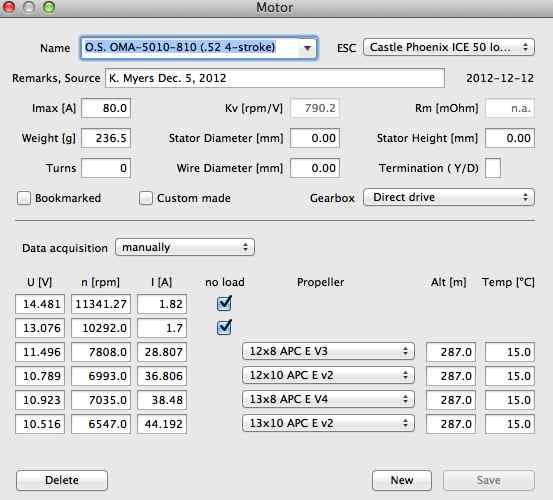
Motor Data Input Screen Capture
|
A screen capture of the Drive Calculator motor input data shows the Drive Calculator calculated Kv of 790.2. Those who do "burst flying" such as 3D or Limited Motor Run (LMR) might feel comfortable using the motor at 234g * 4.5 watts in/g = 1050 watts in, but since I don't do those types of flying, I cannot recommend it. There is a problem with the Propeller Data Chart for the OMA-5010-810 as presented in the Owner's Instruction Sheet and in the O.S. Motor Online specifications .pdf. I've reproduced the chart along with a chart for the Drive Calculator's predictions. The elevation was set to 287m and the temperature was set to 22-deg C. A power meter should be used to note the actual current draw at various elevations and temperatures. However, these predictions should be much closer to real world measurements than those presented by O.S. Motor. |
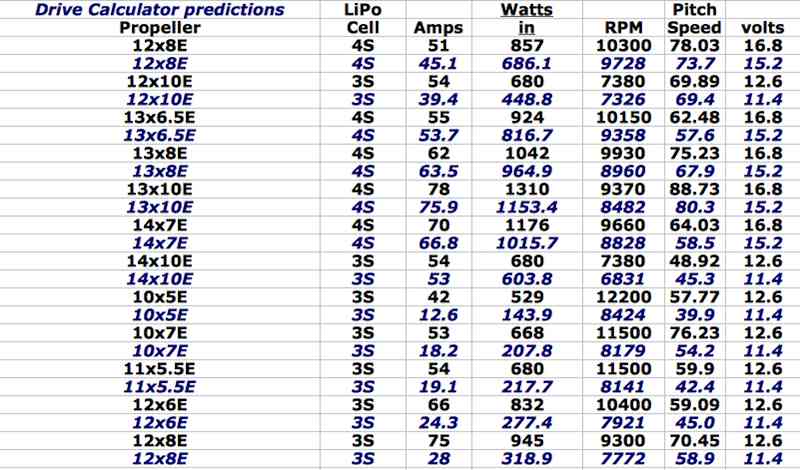
Drive calculator predictions in BLUE & O.S. Data in BLACK
|
The voltages in the Drive Calculator's predictions are based on 3.8 volts per cell. That is about the voltage per cell, after the first 10 seconds or so at maximum power for a decent Li-Poly battery of the correct C rating. When looking at the prop chart, it is important to remember that O.S. rates this motor to 45 amps continuous. I do not have any Li-Poly packs to actually verify the numbers in the Drive Calculator calculated chart, but they should be fairly close. As O.S. Motor says in the manual, "Be sure to measure the current value with a measuring instrument." Take the Drive Calculator charted values with a 'grain of salt', but then again, I find the O.S. Motor numbers, especially the 10x5E through 12x8E 3S data, extremely questionable! I have no idea why O.S. motor chose to use 16.8V for a 4S LiPo and 12.6V for a 3S LiPo. O.S. Motor notes that this motor is equivalent to a .52 4-stroke glow motor. That is a very narrow description for use of the motor. The problem is the prop diameter. Typically, the ready to fly (RTF) weight of a 'fly on the wing', scale, sport scale, sport plane or trainer with 550 watts in would be between 4.5 lb./72 oz. and 6lb./96 oz. The majority of existing designs would not have the necessary ground clearance for a 14" diameter prop. Using an APC 12x8E and a 4S 4400mAh/4500mAh LiPo is a good way to go for maximum input with this motor. Drive Calculator data: 15.2V, 49.2A, 747.5Win, 9552 RPM. This power system could handle 'fly on the wing' planes up to 7 lb./112 oz. quite easily and falls within range of what O.S. Motor might be calling .52 4-stroke power. One way of estimating an equivalent power is; 747.5 / 2000 = 0.374 2-stroke equivalent * 1.5 (factor for 2-stroke to 4-stroke equivalent) = 0.56 4-stroke. Regarding the 49.2 amp draw, when a real LiPo is used there is a relatively large voltage drop in the first few seconds of the discharge. It is typical for user data to be gathered with a power meter within the first 10 seconds to 20 seconds of a battery discharge. Since the current would never be higher for any extended period of time, this should not be a problem. 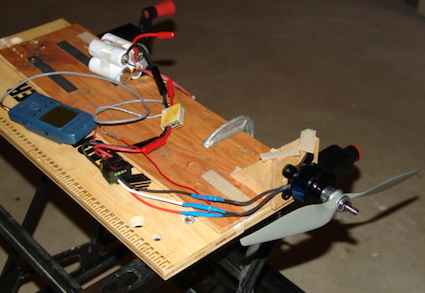
Power System on static bench testing stand This motor is going to be used with an APC 13x8E and 4S "A123" 2300mAh battery. A 3S LiPo and 4S "A123" 2300mAh have approximately the same input voltage, 11.4V, when read in the first few seconds of discharge under load. DC data: 11.4V, 41.3A, 470.6Win, 7254 RPM. My discharge about data about 3 seconds after the maximum amp draw showed 10.82 volts, 37.7amps, 410 watts in and about 7,000 RPM. Using the same math as above; 410 / 2000 = 0.205 2-stroke equivalent * 1.5 = 0.3075 4-stroke. I will be using this motor with a similar power to a 4-stroke .30. Regarding Replacements for AF 15G Motors in a Bell YFM-1A in the January 2013 Ampeer
Ken, I have just a couple of extra thoughts having just read your Jan.13 Ampeer. Regarding David Plummer and his replacements for geared Astro 15's. I might start with this one attached to the Astro gearbox. It is the Turnigy 480S BL Inrunner Motor w/ Impeller 1500kv. I would be looking at 4S A123's, that is guessing that he is using 11 or 12 inch 3-bladed props. Also have you noticed pages 9 and 10 don't follow?? regards
Thanks for the recommendation that I'm passing along. Also, thanks for the heads up on pages 9 and 10 of the .pdf version. Got it fixed, thank to you! KM Feather Merchant
Hi Ken, A recent Ampeer had an article on a fellow with his "Privateer". This is the first plane Ted Buck built and had many years of great flying with. I was given a 90" Feather Merchant by one of my closest buddies before he died. I had originally used this plane for SAM events at our field and a couple at the Michigan SAM club. Four years ago, after changing all models to electric, I decided to Electrify the FM. The weight of this model is 6 lb., wingspan, 90" and it's a beauty. The fellow who built it was a master craftsman, and you can tell by the pictures, his expertise in building. I decided to purchase a Thrust 20 for this model and after quite some time, it came from Australia. The Thrust 20 is all the power it needs with a 11x3.8 on it powered with a 3C, 2200mAh LiPo and using a 36Amp ESC. I keep reading about these A123 batteries and am itching to try them, but can't find them here in London, Ont. (Any idea where I can get em?) And, what charger is used to charge them up? I have a new charger now, I believe I told you about it. Pictures of my Feather Merchant are scarce, I accidentally cleaned up my picture folder and deleted them. Luckily, I found em, on a disc from MAAC, 2006 Nationals. As I said, I used the Thrust 20, could have used a Thrust 30 but the 20 does fly it with authority. Now, as for the A123's, we do have a DeWalt dealer here in town and I will check him out for availability. Hope they aren't too pricey, this stuff really is here in London. Anyway, just thought you'd like to see, and hear what I did with my Feather Merchant. Art Feather MerchantChina Clipper Q500 and an Extra 300XS
Hello Ken, Here are some pictures of my new project, a China Clipper Q-500, that I raced years ago. It shows Ace nylon spacers for mounting the motor. 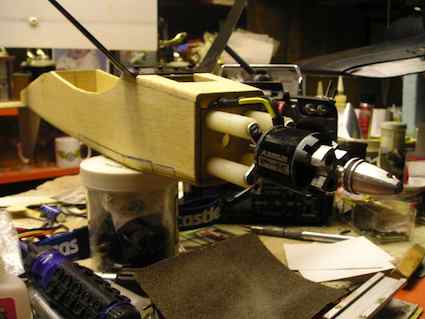 Also photos of my Extra 300xs that I built years ago. It used the nylon spacers also. It had where the battery hooked up in bottom of cowl. I decided to change from A123's to two LiPos. I modified it so I can charge and hook up the batteries from the back. I feel it is much safer. 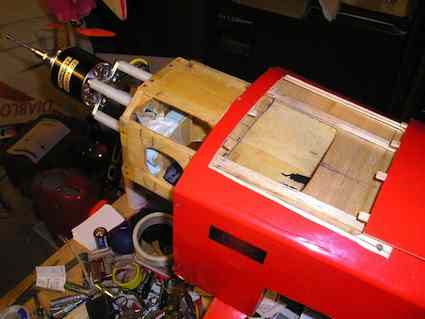 Hooking up farther away from the prop is always a good idea. I'm pretty sure you didn't mean that you were going to charge your LiPos in the plane. That is a BAD idea! KM Looking for RC Micro World?
I was trying to find Bob Aberle's reduced size (150 sq.in.) Phil Kraft KWIK FLI MK-III article in RC Micro World. He had written to me about it back in October. The old Cloud 9 URL didn't work! With a bit of poking around I found that RC Micro World is now at www.fullsizeplans.com. The site is called Cloud 9 RC Micro World & Full Size Plans. Be sure to check it out soon. It's a good 'un. One Cure for Motor "Rumbling"
Hi Ken, I was reading the Ampeer and the discussion you were having with Kyle (Nov. 2012 Ampeer) where he responded with this: "I ran the motor and battery and when I got to full throttle the motor sounded like it was rumbling. At about 3/4 throttle, all was good and it was producing nice power. Once I hit full throttle, the rumble started again. I've got my ICE 100 set to low timing (0) and PW set to outrunner. Cutoffs are set to hard. They were set to soft for prior flights and LVC is set to 3.2. Even with the rumble itŐs still pulling the plane like no other.
I suspect the problem is that he has the PW(M) set at "outrunner" which is too high for the 160 motor. I am confident this is the problem as I had it happen to me a couple years ago with a Power 160. I chased my tail over it until I discovered how to figure out the proper PWM. PWM stands for Pulse Width Modulation, which some ESC manufacturers call "switching frequency". The ESC uses PWM to control the power going to the motor and breaks the current going to the motor into separate pulses that occur about 13,000 times per second. Many ESCs have a a way to select the PWM frequency for the motor being controlled. It varies by manufacturer. How to change it is usually in their documentation, but the default is usually correct and often designated by an "*". Most motors on the market today are "outrunner" types, but they don't always require "outrunner mode". Castle Creations provides information that helps to determine the proper setting, "Use outrunner mode when the commutation frequency will exceed the PWM frequency by a significant amount. If the commutation frequency exceeds the PWM frequency by about a factor of 2 or higher, outrunner mode will perform better." How is the commutation frequency derived? This is the formula: (number of motor poles * motor_RPM) / 20 Here's an example of how that will work:
An eight pole motor, running at 24,000 RPM will have a commutation frequency of 9.6kHz (9600) commutations per second). This motor should run just fine on 8kHz or 12kHz PWM. A twelve pole motor, running at 30,000 RPM will have a commutation frequency of 18kHz.
This motor might benefit from Outrunner mode. Hope that might help him out. If he selects a lower PWM in the ESC, I think the rumbling will go away. Take care,
Power Meters and a Bristol M1C
Hi Ken, (Referring to the October 2012 Ampeer. KM) It looks like a whole pile of new info on Watt meters, but nothing I could cram into my wee brain. I use the old, trusted E-Flite watt meter, a simple one with readings I can understand, I think. After reading your latest, I'm wondering if I should investigate this new one?Ę Why should I, was my question. There seems to be more info in there that I don't understand. Being just a "Fun Loving Electric flyer" I don't think I should go that route. Or am I missing something? The November issue had the review of the AEO P1 HV Watt Meter. What you should have gotten out of the article is that it is not very accurate and difficult to use. I believe that you did get that! The Electrifly PowerMatch, which was reviewed in the December 2012 issue is a much, much better tool than the E-flite Watt meter you have now. KM Those winds you had moved our way and really curtailed our outdoor flying for October. None the less, it has given me time to start another project, similar to my 50" sBach. It also is a profile, kinda scale, model of a Bristol M1C. It is a plane I've always liked, especially after having a Balsa USA one with an OS 80 4-stoke. Since the electric bug has bitten, I've gotten rid of all gassie stuff and only fly electric now. The sBach has had 12 flights on it, mostly late September and a couple in early October before the winds and rain started. It came out at 4.25 lb. It flies great with the motor I got from HeadsUp and four cell LiPo. The Bristol is almost done. All of the cutting was done with my "Special" hot wire bow and an old soldering gun with a home made thingamabob for cutting small stuff. So far, the cutting has come out great. It took some time to get used to not shaking while following the lines, but I finally did it. 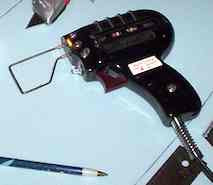  For paint scheme, I'm copying the one that's in the Australian Museum, Red Devil. It is easier to paint and has no special camouflage colors on it. I plan on using the Thrust 20 on my Bristol. The target weight is hopefully around the 3 lb. I know both these are both "Profile" models, but this is the easiest way to go for me since I can't use CA anymore or Epoxy. 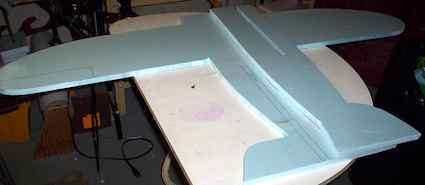 |
To Reach Ken Myers, you can land mail to the address at the top of the page. My E-mail address is: KMyersEFO@theampeer.org
